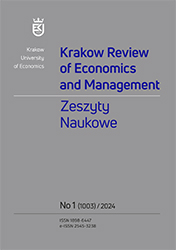Challenges in Cooperating with Robots as Team Members
DOI:
https://doi.org/10.15678/KREM.2024.1003.0106Keywords:
robots, cobots, teams, human-robot collaborationAbstract
Objective: To assess views on working with robots in a team and the most important concerns and expectations related to “employing” robots.
Research Design & Methods: Quantitative research was carried out using a survey questionnaire among a group of 593 IT specialists.
Findings: Robots are still treated mainly as tools, not as entities that participate in a team’s work. The belief that the presence of a robot on a team will not eliminate a human but instead replace it, performing dangerous and uncomfortable tasks and providing space to focus on more creative activities, leads some to view the employing of robots in teams in a positive light.
Implications / Recommendations: The creators of robots should be aware that robots will be team members that enter into relationships with people alongside whom they carry out professional tasks. Preparing – or being prepared, in the case of robots – to cooperate in such teams is a crucial task in modern human resource management.
Contribution: Research on teams in which robots cooperate with people is a novelty in the Polish literature on the subject. The article may help inspire further exploration of this research area.
Downloads
References
Arslan, A., Cooper, C., Khan, Z., Golgeci, I. i Ali, I. (2021). Artificial Intelligence, and Human Workers Interaction at Team Level: A Conceptual Assessment of the Challenges, and Potential HRM Strategies. International Journal of Manpower, 43(1), 75–88. https://doi.org/10.1108/IJM-01-2021-0052
Asimov, I. (1942). Runaround. Pobrane z: https://web.williams.edu/Mathematics/sjmiller/public_html/105Sp10/handouts/Runaround.html (data dostępu: 15.01.2023).
Barden, J. (2022). The Pros and Cons of Having Robots in the Workplace. Pobrane z https://www.zippia.com/employer/the-pros-and-cons-of-having-robots-in-the-workplace/ (data dostępu: 15.02.2023).
Berreby, D. (2022). Automatyzacja pracy. Czy roboty przejmą najlepiej płatne zajęcia? [Raport National Geographic]. Pobrane z: https://www.national-geographic.pl/artykul/roboty-jak-te-inteligentne-technologie-zmieniaja-nasze-zycie (data dostępu: 15.01.2023).
Chamorro-Premuzic, T. i Ahmetoglu, G. (2016). The Pros and Cons of Robot Managers. Harvard Business Review.
Chłopek, G. (2020). Czy sztuczna inteligencja zastąpi testerów? Pobrane z: https://bulldogjob.pl/readme/czy-sztuczna-inteligencja-zastapi-testerow (data dostępu: 20.02.2023).
Coboty – czym są, jak działają? Typy cobotów (2021). Pobrane z: https://www.automatyka.pl/artykuly/coboty-czym-sa-jak-dzialaja-typy-cobotow-194256-6 (data dostępu: 10.03.2023).
Cygert, S., Górski, F., Juszczyk, P., Lewalski, S., Pastuszak, K., Czyżewski, A. i Supernat, A. (2021). Towards Cancer Patients Classification Using Liquid Biopsy. W: I. Rekik, E. Adeli, S.H. Park, J. Schnabel (red.), Predictive Intelligence in Medicine (s. 221–230). Springer.
Demir, M., McNeese, N. J. i Cooke, N. J. (2020). Understanding Human-robot Teams in Light of All-human Teams: Aspects of Team Interaction and Shared Cognition. International Journal of Human-Computer Studies, 140, 102436. https://doi.org/10.1016/j.ijhcs.2020.102436
Escott, E. (2017). Bots vs Robots: What’s the Difference? Pobrane z: https://codebots.com/artificial-intelligence/robots-and-bots-explained (data dostępu: 25.02.2023).
Górska, A., Guzal, P., Namiotko, I., Wędołowska, A., Włoszczyńska, M. i Rumiński, J. (2022). AITP – AI Thermal Pedestrians Dataset. 15th International Conference on Human System Interaction (HSI), 2022, https://doi.org/10.1109/HSI55341.2022.9869478
Jung, M., Sabanovic, S., Eyssel, F. i Fraune, M. (2017). Robots in Groups and Teams. CSCW 2017, February 25–March 1, 2017, Portland, OR, USA. Pobrane z: https://www.researchgate.net/publication/313803343_Robots_in_Groups_and_Teams (data dostępu: 15.02.2023).
Knecht, T. (2021). A Brief History of Bots and How They’ve Shaped the Internet Today. Pobrane z: https://abusix.com/resources/botnets/a-brief-history-of-bots-and-how-theyve-shaped-the-internet-today/ (data dostępu: 3.02.2023).
Kołodziejska, D. (2001). Kształtowanie poczucia podmiotowości. Edukacja i Dialog, 125.
Ma, L. M., Fong, T., Micire, M. J., Kim, J. K. i Feigh, K. (2017). Human-robot Teaming: Concepts and Components for Design. W: B. Siciliano, O. Khatib (red.), Springer Proceedings in Advanced Robotics (s. 649–663). Springer.
Manikowska, M., Sadowski, D., Sowinski, A. i Wrobel M. R. (2023). DevEmo – Software Developers’ Facial Expression Dataset. Applied Sciences, 13(6), 3839. https://doi.org/10.3390/app13063839
Marous, J. (2015). Robots and AI Invade Banking. Pobrane z: https://thefinancialbrand.com/news/data-analytics-banking/artificial-intelligence-banking/robots-artificial-intelligence-ai-banking-52735/ (data dostępu: 10.03.2023).
Matthews, K. (2018). 6 Tips for Balancing the Robotics and Humans on Your Team. Pobrane z: https://blog.robotiq.com/6-tips-for-balancing-the-robotics-and-humans-on-your-team (data dostępu: 15.02.2023).
Naneva, S., Sarda Gou, M., Webb, T. L. i Prescott, T. J. (2020). A Systematic Review of Attitudes, Anxiety, Acceptance, and Trust towards Social Robots. International Journal of Social Robotics, 12, 1179–1201. https://doi.org/10.1007/s12369-020-00659-4
Nasze życie z robotami. Tam gdzie człowiek nie może – lub mu się nie chce (2023). Pobrane z: https://mlodytechnik.pl/technika/29642-nasze-zycie-z-robotami-tam-gdzie-czlowiek-nie-moze-lub-mu-sie-nie-chce (data dostępu: 15.01.2023).
Ptaszyn, N. (2017). Generacje robotów i ich podział ze względu na zastosowanie. Pobrane z: https://ofertyprzemyslowe.pl/generacje-robotow-podzial-ze-wzgledu-zastosowanie/ (data dostępu: 20.02.2023).
Sebo, S., Stoll, B., Scassellati, B. i Jung, M. F. (2020). Robots in Groups and Teams: A Literature Review. Proceedings of the ACM on Human-Computer Interaction, 4, CSCW2, 176. https://doi.org/10.1145/3415247
Smids, J., Nyholm, S. i Berkers, H. (2020). Robots in the Workplace: A Threat to – or Opportunity for – Meaningful Work? Philosophy & Technology, 33, 503–522. https://doi.org/10.1007/s13347-019-00377-4
Thomas, L. (2019). Humans, Robot Teams Work Better When There’s an Emotional Connection. Pobrane z: https://news.umich.edu/humans-robot-teams-work-better-when-theres-an-emotional-connection/ (data dostępu: 20.02.2023).
Traeger, M. L., Sebo, S. S., Jung, M. i Christakis, N. A. (2020). Vulnerable Robots Positively Shape Human Conversational Dynamics in a Human–robot Team. The Proceedings of the National Academy of Sciences, 117(12), 6370–6375. https://doi.org/10.1073/pnas.1910402117
Types of Robots: Characteristics and Classification (2023). Pobrane z: https://www.postposmo.com/en/tipos-de-robots/ (data dostępu: 25.02.2023).
Urwan, S., Wysocka, D. R., Pietrzak, A. i Cwalina, K. K. (2022). Position Estimation in Mixed Indoor-outdoor Environment Using Signals of Opportunity and Deep Learning Approach. International Journal of Electronics and Telecommunications, 68(3), 594–607. https://doi.org/10.24425/ijet.2022.141279
Wierciński, T., Rock, M., Zwierzycki, R., Zawadzka, T. i Zawadzki, M. (2022). Emotion Recognition from Physiological Channels Using Graph Neural Network. Sensors, 22(8), 2980. https://doi.org/10.3390/s22082980
You, S. i Robert, L. P. (2019). Trusting Robots in Teams: Examining the Impacts of Trusting Robots on Team Performance and Satisfaction. Proceedings of the 52th Hawaii International Conference on System Sciences, January 8–11, Maui, HI, Forthcoming. Pobrane z: https://papers.ssrn.com/sol3/papers.cfm?abstract_id=3308180 (data dostępu: 15.02.2023).
You, S. i Robert, L. P. Jr. (2022). Team Robot Identifcation Theory (TRIT): Robot Attractiveness and Team Identifcation on Performance and Viability in Human–robot Teams. The Journal of Supercomputing, 78, 19684–19706. https://doi.org/10.1007/s11227-022-04645-7
Young, J. E. (2015). How to Manage Robots and People Working Together. Pobrane z: https://www.wsj.com/articles/how-to-manage-robots-and-people-working-together-1433301051 (data dostępu: 20.02.2023).
Downloads
Published
Issue
Section
License
Copyright (c) 2024 Zeszyty Naukowe Uniwersytetu Ekonomicznego w Krakowie / Cracow Review of Economics and Management

This work is licensed under a Creative Commons Attribution 4.0 International License.




